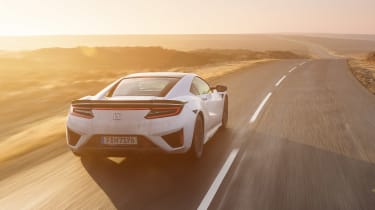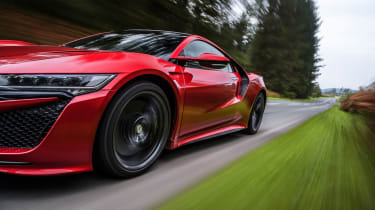Honda NSX (2016-2022) – engine and gearbox
Hybrid drivetrain is beautifully integrated, while the nine-speed twin-clutch is a quick and smooth ally
Providing the bulk of the power is that twin-turbo V6, which puts out 500bhp between 6500 and 7500rpm and 406lb ft of torque between 2000 and 6000rpm. In addition to this is a direct drive electric motor situated between the engine and the nine-speed dual clutch transmission.
The electric motor generates an additional 47bhp at 3000rpm and 109lb ft between 500 and 2000rpm. Finally there is also a Twin Motor Unit on the front axle, each of these motors puts out 36bhp at 4000rpm and 54lb ft between 0 and 2000rpm. The maximum outputs (obviously not arrived at simply by adding up all the individual maximums) are 573bhp and 476lb ft. As with almost all hybrid systems the Honda can run on electricity or petrol alone, or a combination of the two, something it does to impressive effect at low speeds, the motors adding extra muscle to the internal combustion engine. Where the NSX gets really clever is in its use of forward pair of motors for torque vectoring duty.
> McLaren P1: review, history, prices and specs
Let’s begin with Quiet mode, which you can either view as a boring very un-supercar sort of mode or quite a cool stealthy ninja method of slipping along unnoticed. Like the Porsche’s 918, the Honda can slide silently off a driveway early in the morning without waking the household. The engine will kick into life, but, as you’d expect, only quietly.
More reviews
Sport is next up and feels like a rather redundant mode. It’s a sort of everyday driving mode, but with an engine that sounds really quite unpleasant. Not loud, just lacking in any musicality. Better, to jump straight to Sport+ if you want a bit more urgency.
The engine is much more vocal, with more sounds of turbocharging but needs to be above 4000rpm to achieve a soundtrack worthy of a sportscar. Once up there it sounds really rather good though, with the hollow induction bark being channeled into the cockpit via some piping behind you.
The nine-speed DCT ‘box is impressive when left to its own devices. When you take control via the paddles, it is quite easy to run into the rev-limiter at 7500rpm and I found that you frequently had to make one last extra downchange on the way into corners to ensure you were in a low enough gear. Most automatics and double-clutch transmissions aren’t calibrated to change down sufficiently before a corner, or hold onto gears for long enough when driving enthusiastically or on track. The NSX, however, responds exactly how you would want it to, always being in the gear you’d naturally select anyway.



